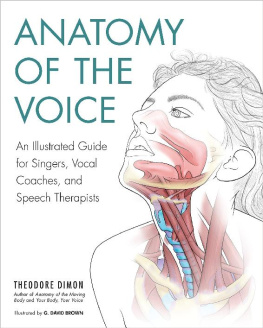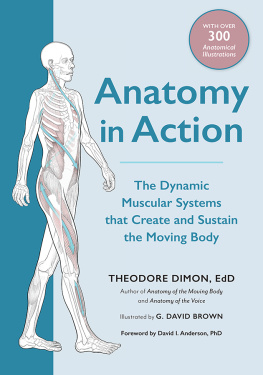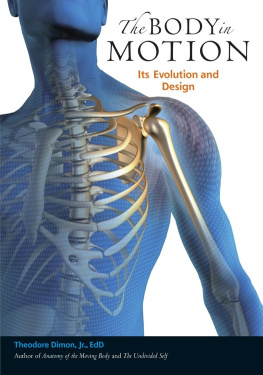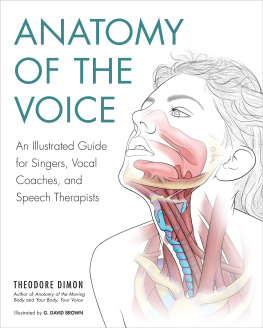ANATOMY OF THE VOICE
ANATOMY OF THE VOICE
An Illustrated Guide for Singers, Vocal Coaches, and Speech Therapists
THEODORE DIMON
Illustrated by
G. DAVID BROWN

North Atlantic Books
Berkeley, California
Copyright 2018 by Theodore Dimon. All rights reserved. No portion of this book, except for brief review, may be reproduced, stored in a retrieval system, or transmitted in any form or by any meanselectronic, mechanical, photocopying, recording, or otherwisewithout the written permission of the publisher. For information contact North Atlantic Books.
Published by
North Atlantic Books
Berkeley, California
Cover art and all illustrations by G. David Brown
Cover design by Howie Severson
Anatomy of the Voice: An Illustrated Guide for Singers, Vocal Coaches, and Speech Therapists is sponsored and published by the Society for the Study of Native Arts and Sciences (dba North Atlantic Books), an educational nonprofit based in Berkeley, California, that collaborates with partners to develop cross-cultural perspectives, nurture holistic views of art, science, the humanities, and healing, and seed personal and global transformation by publishing work on the relationship of body, spirit, and nature.
MEDICAL DISCLAIMER: The following information is intended for general information purposes only. Individuals should always see their health care provider before administering any suggestions made in this book. Any application of the material set forth in the following pages is at the readers discretion and is his or her sole responsibility.
North Atlantic Books publications are available through most bookstores. For further information, call 800-733-3000 or visit our website at www.northatlanticbooks.com.
e-ISBN 978-1-62317-198-8
Library of Congress Cataloging-in-Publication Data
Names: Dimon, Theodore, Jr., author. | Brown, G. David, illustrator.
Title: Anatomy of the voice : an illustrated guide for singers, vocal coaches, and speech therapists / Theodore Dimon; illustrated by G. David Brown.
Description: Berkeley, California : North Atlantic Books, [2018] | Includes index.
Identifiers: LCCN 2017046674 | ISBN 9781623171971 (trade paper)
Subjects: | MESH: Larynxanatomy & histology | Larynxphysiology | Work of Breathing | Voice
Classification: LCC QP306 | NLM WV 501 | DDC 612.2/33dc23
LC record available at https://lccn.loc.gov/2017046674
North Atlantic Books is committed to the protection of our environment. We partner with FSC-certified printers using soy-based inks and print on recycled paper whenever possible.
TABLE OF CONTENTS
T his book has been written as a reference for singers, vocal coaches, speech therapists, and students of voice who require detailed information on the anatomy of the voice and how it works. Although many books on singing and speech are currently available, very few of them actually present the basic anatomy of the voice in clear and simple terms, which is the aim of this work. Readers familiar with my first book on the voice, Your Body, Your Voice, will know that I have already presented a new approach to the subject of voice production. This new book complements the first volume, in which the basics of anatomy of the voice were not included.
In compiling basic anatomical information on the voice, the first question that arises is what to include. In this book I have identified five basic systems that are responsible for vocal production:
The first, and in many ways the most basic part of the voice, is the respiratory system. Although sound is produced in the larynx, this would not be possible without the flow of air from the lungs. This airflow provides a necessary power source to set the vocal cords into motion to produce sound. In well look at the anatomy of breathing.
examines the second system, the larynx, which is the most immediate physical structure pertaining to the voice. Its role in vocal production and its highly specialized functions are so important that it merits a key place in a basic anatomical reference on the voice. The larynx forms the housing for the vocal folds that vibrate to make sound, bringing them together when we want to speak or sing, and pulling them apart when we breathe normally. Though the intricate design of the larynx does not lend itself to easy comprehension of its function, when we break down its component parts and look at them in turn, it begins to make sense.
The larynx itself is suspended within a network of musclessometimes called the extrinsic muscles of the larynxthat move the structure when we swallow and help it to function. These constitute the third system we will examine. Although the role of these muscles in swallowing is well understood, their role in vocalization has been largely misunderstood and underestimated. Well look at the function of these muscles in .
The fourth basic system is the vocal tract, which is made up mainly of the pharynx but also includes the oral cavity and the position of the larynx. It is here that we break up the sounds coming from the larynx into speech. It is also here that the sound from the vibrating vocal folds is augmented. Because the vocal tract is not fixed in shape but can be altered by how we use the different structures such as the mouth, tongue, and palate, it forms a crucial part of vocal training. Well look at these elements in detail in .
Because the face also occupies a practical role in vocal training, I have included a describing the muscles of the face as they relate to vocal placement. Here I have also included the jaw, since it naturally belongs in this section.
In the we will look at the function and evolution of the larynx in particular, and the voice in general. Because the larynx is so complex, it is nearly impossible to appreciate why it is the way it is without having some sense of how it evolved, which in turn helps to make some of its features more understandable.
THE ANATOMY OF BREATHING
B reathing is one of the most vital of our life processes. All day long, throughout our lives, we take in air in order to provide cells throughout the body with oxygen and then expel carbon dioxide from the lungs in order to rid the body of wastes produced by cellular activity. Secondarily, breathing is the power source that sets the vocal folds into motion to produce sound. To do this, we do not exhale normally but alter our breathing so that we can produce the sustained sounds of speech and song.
Although breathing refers to the flow of air into and out of our bodies, we actually breathe by altering the size of our chest cavity, not by doing something to the air. By making the space within the chest cavity get larger and smaller, air flows into and out of the chest through either the nose or mouth. That simple exchange of air is what we call breathing.

). The uppermost ribs connect in front to the sternum; those below form an arch beneath it; the last two, the floating ribs, do not attach in front. Because of this, not all the ribs move in the same way, or to the same degree. But most of the ribs rise and widen to some extent, making the space inside the chest larger; when they return to their lower position, the space gets smaller.















